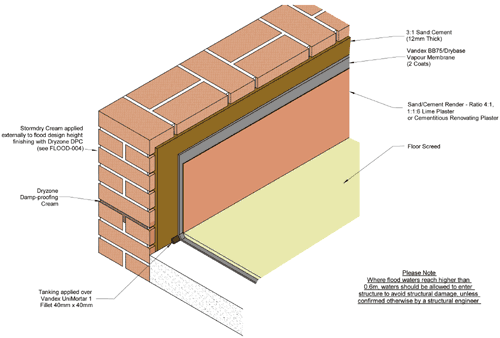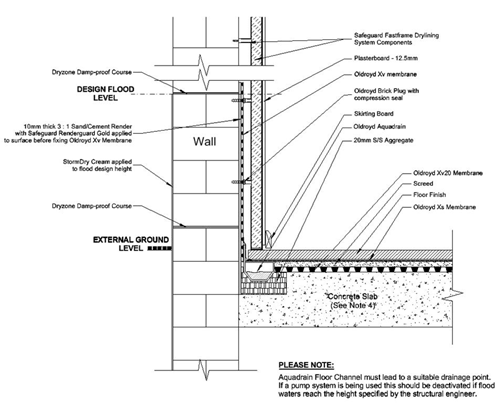Flood resistance and resilience
Owners of buildings in flood risk areas may wish to upgrade their properties to improve their performance in the event of flood – minimising the cost of repairing flood damage and enabling faster reoccupation of the flood affected building.
The first thought that comes into most people’s minds is to take measures to prevent flood water from entering the property – e.g. flood doors, air-brick seals, waterproof coatings. This is known as “flood resistance” and is a practical flood protection measure for many properties. However, flood resistance cannot be relied on in all situations. For example, in some cases the building structure may be unable to cope with the pressures exerted by high levels of flooding or it may simply be impractical to install flood resistance measures that can be relied upon to provide adequate protection. In these cases the alternative strategy of “flood resilience” can be employed. Flood resilience involves accepting that flood water will enter the property and taking measures to minimise the damage and disruption caused to the building.
Flood Resistance

A number of measures can be adopted to provide resistance to flood waters in buildings at risk of flooding. Openings such as doors, windows, air bricks, and services will need to be identified and sealed using proprietary systems – e.g. flood doors. Safeguard offer a range of products that can be used to improve the flood resistance of masonry walls. The choice of system will depend on a number of factors such as the substrate condition, type of masonry (brick, stone, etc…) and whether or not an external rendered finish is acceptable.
Products used to improve the flood resistance of masonry include;
- Vandex BB75 Tanking Slurry
- Vandex Unimortar 1 High Build Slurry
- Stormdry Masonry Protection Cream (in conjunction with Stormdry Repointing Additive No.2.)
- Drybase Liquid-Applied DPM
The diagram below shows a typical flood resistance system using a combination of the above products. Further options can be found on our Flooding CAD Detail page.

Flood Resilience
Where it is accepted that flood water will enter the building – e.g. because flood resistance measures are impractical or would be unable to cope with a high flood level (e.g. above 0.6 metres) – flood resilience measures can be put in place to minimise the damage and disruption caused by the flood.
Typical flood resilience measures include the use of tiled surfaces that can easily be cleaned after a flood and the siting of electrical sockets and circuits above the design height level.
A further aspect of flood resilience is the management of ingressing flood waters – diverting them away from where they would cause the most damage. Such a solution can be installed using Oldroyd cavity drainage membranes as shown in the diagram below. Further options can be found on our Flooding CAD Detail page.

It should be noted that flood resistance and flood resilience are not mutually exclusive. Many flood resilience specifications will include flood resistance measures. For example, flood resilience measures may be employed in case of a worst case scenario in which high flood levels cause flood water to enter a building. However this does not prevent flood resistance measures being employed to prevent water entering the building at all during a less severe flood.
Further Information
If your property has been affected by flooding, or if you would like information on improving your property’s capacity to deal with a flood, please contact our technical department on 01403 210204 or submit an enquiry.